Women’s efforts were often not acknowledged in the historical documents of the Church. The Churches depended on the voluntary labour of women to stay solvent, often overlooked by Parish councils and the male Church historians. Bazaars were big money spinners.
A reviewer of the opening of a bazaar said “In our youthful days it was one of the strongest articles of our social creed that ladies never looked so lovely as at a bridal except when they presided at a stall at a fancy fare’. The experience of fetes and bazaars created a sense of community among women. Concerts, parish get-togethers were very important in creating community for these colonial immigrants from England.
Women’s organisations were formed, but the patriarchal structure of the Church did not give women much affirmation. Women were excluded from parish office-holding which was to come decades later.1
Two for the price of one
In this paper Le Couteur draws on the very little material on Anglican clergy wives in early colonial Queensland.
A clergyman and his wife had to share a calling. The life of a clergy wife was incorporated into her husband’s job. It was difficult, if not impossible for her, to separate herself from the demands of his parish ministry. His job intruded into almost every aspect of domestic life, from the impact of his timetable onto daily routine, to the hospitality expected of the parsonage to all kinds of people, and her active participation in his pastoral ministry. In terms of their work, it was manifestly, two for the price of one. The key point to fully appreciating this is that her proxy activities implicitly recognise her competence and expertise.1
1. Finch J. Married to the job; Wives’ incorporation in Men’s Work. London, Allen & Unwin, 1983, p.70
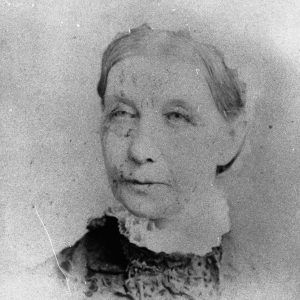
Mary Glennie (1826–1890)
The lot of a clergy wife dedicated to charitable works.
Click for More
The work of clergy wives was, and is, largely unsung. A striking example of the clergy wife dedicated to charitable works is Mary Glennie. She followed her husband to the Darling Downs and then Toowong, establishing many benevolent organisations along the way including the Girls’ Friendly Society.
Archdeacon Benjamin Glennie was a significant person in the early years of the Diocese, but one who is equally important but less well known in Diocesan history is Mary Glennie, his wife. So little was known of Mary Glennie that it caused some people to ask “I didn’t even know Benjamin Glennie was married.” In her story we see what an impact Mary Glennie made in the Diocese, an indication of the strength of character of this seemingly unremarkable, quiet woman.
Mary Glennie was born in England in 1826, apparently well educated. In 1861 she came to Australia as a chaperone to her friend Kate Fowler. She lived in Warwick where she met Benjamin Glennie whom she married in 1868.
They went to Drayton Church of England Church, Darling Downs, where she shared with her husband the multifarious tasks which fell to the lot of a clergyman’s wife.
When the Glennies were transferred to Toowong Mary Glennie gave whole hearted devotion to religion and charity. She assisted in the inauguration of the Governesses’ Home and Young Women’s Institute to assist women who were forced through no fault of their own to seek employment to maintain themselves, a home which operated until 1927. She established the Girls’ Friendly Society in 1882. Mary Glennie was active in the North Brisbane Benevolent Society and St John’s Temperance Society. She was a long and active member of the Lady Bowen Hospital committee.
Mary Glennie died in 1890. The Brisbane Courier reported that her death would be felt not only by her venerable husband, but by a large number of attached friends, as well as by the poor and afflicted among whom she so long and so devotedly laboured.
Further information
https://trove.nla.gov.au/newspaper/article/20282690
http://nla.gov.au/nla.news-article170833052
www.glennie.qld.edu.au/connect/enews-archive/from-the-archives-the-story-of-mary-glennie/
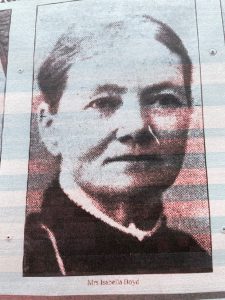
Isabella Boyd (circa 1843 – 1916)
A Pioneer Woman of Brisbane Diocese
Click for More
Isabella Boyd made an outstanding contribution to the Brisbane Diocese in the 19th and early 20th century. Unlike many women of her era whose work was often not acknowledged, she has been given tangible recognition in the form of a commemorative stained glass window, depicting St Peter, in the Apse of St John’s Anglican Cathedral, Brisbane. Her story explains why she is remembered in her era.
Isabella Boyd was born in Carlow, Ireland, daughter of Revd George Boulter Dawson (her Mother’s name unrecorded). At the time of her death in 1916, she had spent over 50 years in Queensland. In 1862 she married William A.J. Boyd (known as Alexander). Isabella was registered as an Assistant Teacher. In 1871 they moved to Pimpama, near Brisbane, where they were pioneers in sugar and rice growing.
They moved to Townsville in 1873 where Alexander was Headmaster of Townsville Central State School, assisted by Isabella. They moved to Brisbane in 1875, to prepare for the opening of a private school, Eton Preparatory School. During this time Isabella Boyd devoted herself to various charities. She was an indefatigable Church worker, and for 25 years she was hon. secretary of the Central Girls’ Friendly Society. She was also president of the Cathedral Embroidery Guild. Other committees she was involved in were the National Council of Women, the District Nurses’ Home and the Lady Musgrave Lodge. Following her resignation from these Committees she was elected as a life member of many of these organisations. Isabella Boyd had a conspicuous claim upon the gratitude of the Queensland Province. For twenty years she had been the moving spirit in organising the Synod teas. It was reported in the Church Chronicle (1906) that she was known as “the high priestess of those admirable Synod teas where excellence constitutes at once one of the principal incentives to regular attendance at Synod and one of the chief hindrances to effective debating at the evening sessions.” At the conclusion of Synod in 1906 the Archbishop voiced the thanks of all members of Synod and presented Isabella with a handsome silver-backed toilet set, consisting of brush, comb, mirror and pin-tray.
Isabella Boyd died in 1916. Her funeral was held at St John’s Cathedral where she was given the highest honour the Church of England could pay, with the form of service chosen by the Archbishop and Canon of the Cathedral. The internment of her body took place at Toowong Cemetery. Isabella Boyd’s life is commemorated by a stained glass window in the Apse of St John’s Cathedral, two depictions of St Peter, a gift of the Girls’ Friendly Society in 1920.
Dr Gwenneth Roberts, assistance of Mr Michael Rogers, Diocesan Archivist
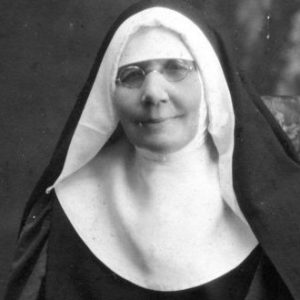
Emma Crawford (1864-1939)
Nun, founder of schools and educator of girls
Click for More
Emma Crawford, better known as Mother Emma, was instrumental in the establishment of schools for girls in Queensland. She was the leader of the Society of the Sacred Advent for 33 years from 1906 to her death in 1939.
Mother Emma, who led the Society of the Sacred Advent from 1906 for 33 years, saw its work and influence extend into the field of education. Religious instruction was banned in Queensland schools under the Education Act of 1875. Under Sister Emma’s stewardship, Anglican girls’ schools were established in all three Dioceses in Queensland – Brisbane, North Queensland, and Rockhampton. The success of these schools led to the provision of a unique and precious education for thousands of girls throughout Queensland.
Emma Crawford, teacher and Mother Superior, was born at Woolwich, Kent, England. Well educated and probably with some teaching experience, she came to Queensland shortly before her admission to the Anglican Society of the Sacred Advent in September 1896.
During World War 1 Mother Emma accepted the invitation of Bishop Feetham, North Queensland, to establish boarding schools for country girls in his Diocese at Townsville, Herberton and Charters Towers. After the war she acquired All Saints Hostel, Charleville, for far-west children attending the local state school, and in 1922 she accepted responsibility for St Martin’s War Memorial Hospital in Brisbane. Her last major venture was the foundation of St Aidan’s School at Corinda in February 1929.
Under her leadership she managed to get the balance right between the spiritual, the secular and the material sides of life. This in turn helped to make the Girls’ Schools in Queensland so successful and unique. Children loved Mother Emma and in turn she loved children. Her gentle nature and her calmness and sincerity appealed to them.
When Mother Emma died of cancer in 1939, the Society was working in three of five Queensland dioceses. The Society never had more than thirty professed Sisters. On her death Bishop Feetham described her as ‘the principal benefactress of this Diocese’. Her most significant contribution was in moderating materialism and secularism in many aspects of Queensland life. A contemporary in the Society described her as every inch a lady who could be icy if displeased, but always remained calm, even under great stress. Once, she managed to persuade Archbishop Donaldson to her point of view on which his opinions had been equally firm.
https://adb.anu.edu.au/biography/Crawford-emma-5811
Geise R.F. The Sisters of the Society of the Sacred Advent and their contribution to Educating Girls Since 1895. Victory Press, Bribie Island, 2012

Zina Cumbrae-Stewart (1868-1956)
Community, social and charity worker, advocate for women
Click for More
Zina Cumbrae-Stewart was a leading light in the Australian Red Cross. She was an executive member in Queensland for 22 years. She led campaigns against the exploitation of children and for domestic science education. In 1931 she helped found the Queensland Social Service League which provided aid during the Great Depression.
Zina Cumbrae-Stewart, a deeply committed Evangelical Anglican, President of Mother’s Union for 9 years, was very involved in community and charitable service. These included Australian Red Cross, President of the National Council of women (1926-35), a founder of Queensland Social Service League. She organised a luncheon at the Lyceum Club in 1928 for the visit of Maude Royden, an English suffragette, and first campaigner for the ordination of women in England in the early 20th century.
Zina Beatrice Selwyn Cumbrae-Stewart, community worker, was born at Brighton Victoria, the daughter of Robert Hammond, a stock and station agent and her Mother Jessie. Her Father died in 1875 leaving a widow and ten children. Zina grew up in the lively social life of well-to-do Brighton society until the bank crash of 1893 ruined her Mother. She attended Mrs R. Sadleir Forster’s Ladies School , St Kilda, and returned there to teach drawing. In 1906 she married Francis Cumbrae-Stewart.
They lived in Brisbane and their only child was born in 1908. Her husband became Registrar of the University of Queensland, so she was a well connected woman in the upper echelons of society. A deeply committed evangelical Anglican, Zina undertook community and charitable service. She won its long service medal as an executive member of the Australian Red Cross in Queensland for twenty-two years. She led campaigns against the exploitation of children and for domestic science education; she sought different sections for the sexes in community organisations. In 1931 she helped found the Queensland Social Service League to cope with Depression problems, joined its executive and became vice-president of the women’s division. Through the National Council of Women she was on the Australian Broadcasting Commission’s education committee for four years. A fluent speaker, she gave some radio talks.
Mrs Cumbrae-Stewart was usually on the executive of the twenty or more societies to which she belonged; they included the Mothercraft Association, the Traveller’s Aid Society, the Bush Nursing Association and the Shakespeare Society. Brusque in public, she had a lively sense of humour in private. She regarded her own abilities as giving her a right to leadership and to the exercise of a formidable dignity. She enjoyed putting down pretentious or silly people but believed nonetheless that her first responsibility was to be a good wife and mother. To her son ‘she was like those grand old ladies whose pictures hang in the National Portrait Gallery in Edinburgh who plainly had no need of rights.’
In 1936 the Cumbrae-Stewarts visited Britain, representing the Queensland Red Cross. She had planned a busy programme of public work which was cut short when her husband’s illness forced a hurried return to their new Melbourne home. After his death she lived with her bachelor son. When he moved to Hobart as deputy parliamentary draftsman she joined him there, making her first flight in 1948. She died in Hobart in 1956 and her body was returned to Melbourne for burial in Burwood Cemetery.
Nancy Bonnin. Australian Dictionary of Biography, Volume 8, (MUP),1981
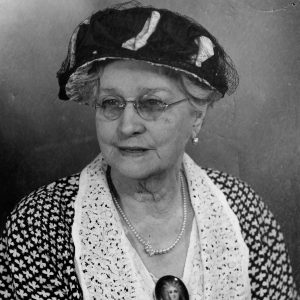
Eliza Tritton (1871–1968)
Philanthropist
Click for More
Eliza Tritton, wife of Frederick Tritton, a well known retailer, was active in Church based charities throughout her 97 years. Among other interests she was a leader of the Girls’ Friendly Society, the Queen Alexandra Home for orphaned children, the District Nursing Association and the Soldiers’ Church of England Help Society.
A well known retail furniture store in George St, Brisbane was established by Frederick Tritton after the 1893 floods. Not so well known in history is his wife Eliza Tritton, a devout Anglican woman, active in charities associated with St Columb’s Anglican Church, Clayfield where she was a leader in Girls’ Friendly Society and Ladies Guild, active in fund raising in fetes and concerts.
Eliza Worrall, born in 1871, migrated to Australia and married Frederick Tritton in 1893 at Holy Trinity Anglican Church, Woolloongabba.
Mrs Tritton was a State office bearer of the Girls’ Friendly Society. She established the St Columb’s branch and in 1914 girls spent evenings at Mrs Tritton’s residence. The girls worked for the Sale of Work all year and handed over all their takings for the extension of the Church and painting. Archbishop Donaldson, speaking to GFS in 1915 said “our boys have proved they stuck at things at Gallipoli. And what the boys could do the girls must”.
She left in 1919 as President of the Guild at St Columb’s Church, “a post she has most ably filled for many years”.
The Trittons were the main benefactors of the Queen Alexandra Home of orphaned children, children of single mothers and abandoned children in Coorparoo. Mrs Tritton was the Head of the Management Committee. Her daughter Nell recalls that her Mother took her daughters to Queen Alexandra Home and made them donate their toys to the children. She remembered her Mother telling her that what counted in life was not what you possessed but what you could do for those in need. She was also President of the District Nursing Association.
In 1915 she was a foundation member of the Soldiers’ Church of England Help Society. A meeting of women was convened by Canon Garland, Resident Chaplain of the Camps. Membership was open to any women members of the Church of England on payment of a minimum of 1/- (shilling) monthly. Objects were:
- To raise funds for the work of the Church of England in the Camps.
- To provide social and recreation entertainment for soldiers of all denominations while in Camp.
- To assist Chaplains at the Front
- To assist the work of the Anzac Club for Returned Soldiers
Mrs Tritton formed the Clayfield Branch. Lady Goold-Adams, wife of the Governor of Queensland sat on a charity committee with Mrs Tritton. Over morning tea the Governor’s wife asked her if part of their large home Elderslie could be made available for Red Cross volunteers from Clayfield to use as a packing depot for parcels which were to be sent to Australians overseas. Parcels would include hand-knitted socks, mufflers and balaclava helmets for the Anzacs facing the bitter cold winter of the trenches. Volunteers used the large kitchen to bake fruit cakes and ANZAC biscuits to be sent by ship to southern France, to Australians living in the trenches.
In 1963 Mrs Tritton was awarded an OBE for services to the Church and the community.
At her funeral service in 1968 Jesus’ words were quoted “I am among you as He that serveth, and I have given you an example that you should do as I have done to you”. The late Mrs Tritton in her wonderful service to the Church and community could justly be considered great.
St Columb’s Memorial Church Clayfield. PARISH NOTES, August 1968, Vol.12, No.1
Susanna de Vries. Nell: the Australian heiress who saved her husband from Stalin and the Nazis. Boolarong Press, 2020.
Eliza and Frederick’s marriage register entry (Holy Trinity, Woolloongabba)
Extracts from Girl’s Friendly Society Annual Reports 1909 and 1919
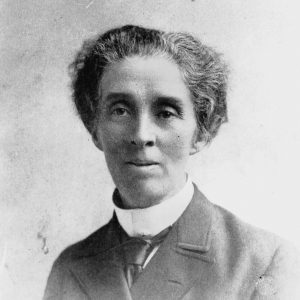
Lilian Cooper (1861–1947)
Doctor and pioneer of hospice and palliative care
Click for More
Dr Lilian Cooper was the first woman doctor in Queensland, the second in Australia. She was an eminent surgeon who overcame entrenched prejudice to practice medicine and is celebrated as a leading figure in women and children’s health and welfare.
From the time of her arrival in Brisbane in 1891 to her death in 1947 aged 86, Lilian Cooper broke down barriers and worked tirelessly to improve women’s lives and health.
Despite the opposition of many male colleagues, Lilian established a private practice and gained honorary positions at the Lady Lamington Hospital for Women and the Hospital for Sick Children. She established a long association as surgeon with the Mater Hospital in 1905, where she was also one of the first Board members. She undertook a study tour of the United States and Britain in 1911 and gained her MD higher degree from Durham University.
Lilian’s skill and standing was recognised when she was the first woman inducted into the inaugural Royal Australasian College of Surgeons in 1928.
A philanthropist and campaigner for public health and women’s rights, Lilian was equally renowned for her dedicated care of her patients and her pithy and colourful turn of phrase. She was once described as a ‘tall, angular, brusque, energetic woman, prone to bad language’. She publicly decried rapidly-expanding Brisbane’s system of poor roads and sanitation, but importantly laid out how to fix it. Her work ethic was legendary, and she mentored and encouraged other women.
Lilian’s legacy continues after her death, thanks to the determined efforts of her life-long companion, Josephine Bedford, who negotiated the gift of their jointly-owned home, “Old St Mary’s” Kangaroo Point to the Sisters of Charity. The Brisbane Anglican Diocese was first offered the property but lacked the resources to accept the gift, which was conditional on building a hospital for the incurably ill and dying.
Lilian and Josephine’s wish became reality in 1957 as the Mt Olivet Hospital and lives on today, renamed St Vincent’s Hospital.
On the Kangaroo Point cliffs adjacent, in St Mary’s Anglican Church is the memorial window of the Warrior’s Chapel which honours Lilian’s faith and service, particularly as a military surgeon with the Scottish Women’s Hospitals during World War 1.
Denied the ability to serve as a doctor by the Australian Army, Lilian along with several other Australian women doctors and a host of women nurses, ambulance drivers, orderlies and administrators from across the Commonwealth performed some of the most courageous acts of WW1 military surgery and service.
During the harsh winter of the Saloniki campaign of 1916-17 in Greek Macedonia, the women, some of whom were veterans of the suffrage campaigns, became pivotal to Britain’s allies, the Serbs and the French who were fighting German backed troops. In frequent danger and sub-zero conditions high up in the Kaymackchalan Pass, Lilian and the women operated, performed amputations and ferried the wounded in ambulances from an advanced dressing station a few miles from the frontline to their field hospital below.
Lilian’s medal of the Order of St Sava awarded by the King of Serbia for her humanitarian service to the country is displayed at St Mary’s Church, Kangaroo Point.
Born in Chatham, Kent to an upper middle class family, Lilian eschewed a traditional path to follow her vocation. She was spurred on in her quest to study medicine by a like-minded spirit, Mary Josephine Bedford, a family friend, and for the next seventy years they would form a formidable partnership, respecting and supporting each other’s abilities and efforts.
It was through contacts of Lady Lamington, the Queensland Governor’s wife, that Lilian and Josephine migrated and made Brisbane their home. This was no easy path to choose. We are a better and more open society because of it.
Press tributes upon Lilian’s death noted she had never married and acknowledged her life-long friend and companion, Miss Jospehine Bedford. The women’s lives and extraordinary achievements are the subject of a book, several plays, numerous histories, a WW1 centenary recital at St Mary’s Kangaroo Point and a State Library of Queensland ‘Dangerous Women’ podcast episode. They are honoured and revered by women and men and celebrated by the LGBTQI+ community.
They are buried together; the inscription on their grave from the Book of Wisdom reads, “They are thine, O Lord, thou lover of souls”.
Author: Lyn Moorfoot, May 2021, with acknowledgement of LM Williams and Susan J Neuhaus.
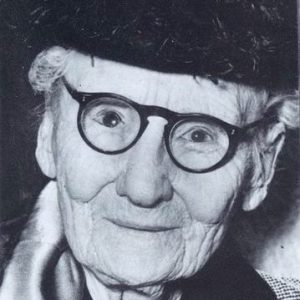
Josephine Bedford (1861–1955)
Public benefactor and companion
Click for More
Josephine Bedford was the lifelong companion of Dr Lilian Cooper, the first woman doctor in Queensland. They emigrated in 1891. Josephine was a benefactor of the diocese.
Mary Josephine Bedford, born 1861 in London, accompanied Dr Lilian Cooper to Brisbane in 1891. She held executive positions in various organisations including the National Council of Women and the committee of the Lady Lamington Hospital and Children’s Hospital. She helped Lilian establish herself as Queensland’s first female doctor while pursuing her own interest in improving the welfare of the state’s women and children. As the city’s population rapidly grew, Josephine noticed that the inner-suburbs, with their unpaved and unsewered streets, were unsafe for children to play. This realisation, along with the help of a local Reverend, led to the creation of the Crèche and Kindergarten Association (C&K) in 1907. By 1911, four centres were operating in Brisbane and a college for kindergarten teachers had been established. On an extended trip overseas, Josephine studied the concept of ‘supervised play’ and returned to Brisbane in 1918 to help open two supervised playgrounds (in Paddington and Spring Hill). The Bedford Playground in Spring Hill commemorates Josephine’s outstanding contribution to Queensland children.
After the death of Dr Cooper she donated the double stained glass windows to St Mary’s Anglican Church, Kangaroo Point, in memory of Dr Cooper. She died in December 1955.
Lilian and Josephine are also embraced by the queer community for their devotion to each other. This is still an unresolved question but there may be new insights to emerge yet about this. They are buried together in the one grave at Toowong Cemetery.
Maude Royden (1876-1956)
First campaigner for the ordination of women in the Church of England (Anglican Church) in the 1920’s.
Click for More
Royden’s tour of Australia in 1928 is important in religious and social history because it touches on discourses of modernity, religion, science and feminism1.
Maude Royden, an English woman, was a suffragette, gifted preacher, Anglo-Catholic tradition, pacificist and first campaigner for the ordination of women in the Church of England (Anglican Church). She was the first woman ever to preach from an Australian Anglican pulpit when she visited Australia in 1928. She was invited to tour on behalf of the British Commonwealth League which was founded in 1925 by two Australian feminists, Miss Marjorie Chave Collisson and Mrs Bessie Rischbieth. Other sponsors were the YWCA, the University Women Graduates’ Association, the St John Ambulance Association, and the League of Nations Union.
Her first preaching engagement at St Mark’s Darling Point, Sydney Anglican Church in 1928 was a courageous endeavour. The same evening she preached at the Pitt St Congregational Church where two thousand people were turned away, with police officers controlling the surging throngs. In doing so, she helped empower others to break new ground for women (and as she saw it, thereby for children and men) and represented the very international and multi-faceted nature of the women’s movement.
Maude’s packed schedule saw her speak and meet church and civic leaders in Sydney, Brisbane, Canberra, Melbourne, Adelaide (where she was the first woman to preach from an Australian Cathedral), Kalgoorlie, and Perth. In Brisbane she was given a Mayor’s Reception, a Governor’s luncheon, and met both the Anglican and Catholic Archbishops, as well as many other leading figures, and women’s organisations. However, she was not invited to St John’s Cathedral in Brisbane but preached at the Albert St City Methodist Church.2,3
The secular press gave Maude Royden extensive coverage and included substantial details of both her lectures and sermons. However, the Church press warned its readers of her unorthodox views. The Australian Church Standard reported that:
She is undoubtedly a remarkable woman, and one who intends to be on the side of right and truth. Some of her books are, like the curate’s egg most excellent in parts…. but she sadly lacks balance, and her demands for the priesthood is not the only case in which her zeal outruns her discretion.
Who was Maude Royden?
Maude was a powerful leader in the women’s and peace movements, in Britain and overseas, and, in published thought and action, in leadership within the Church and in advocacy for a more healthy and reasoned approach to sexuality. Born in Mossley Hill, Liverpool, she was educated at Cheltenham Ladies School and Lady Margaret Hall in Oxford. She obtained what she called her real women’s education however through her work at the Victoria Women’s Settlement in Liverpool. The leading Church feminist of her day and a founder member of the Church League for Women’s Suffrage, she was a significant figure in women’s struggle for the vote and social reform. Maude was also a deeply committed peacemaker, including as secretary of the Fellowship of Reconciliation and a vice-president of the Women’s International League for Peace and Freedom. Her Australian visit was indeed part of efforts to seek a just world order which could avoid war. Responding to invites, she made several international tours, in the USA, Japan, China, Australia and New Zealand, speaking about the League of Nations, social justice, the ministry of women and Christianity. She was the prime mover in the inter-war attempt to form a Peace Army of unarmed passive resisters to intercede between the combatants in the world’s military confrontations, starting with Manchuria. In 1934 she visited India and met Gandhi.
Although disappointed by the lack of Anglican women’s ordination in her lifetime, she was at the heart of the struggle for women’s ministry within the Anglican Church and a ground-breaking pioneer. This began in 1917 when, as a strongly ecumenical Anglican, she accepted an invitation to become assistant preacher at the City Temple in London, being the first woman to occupy such an office in her native land. Supported by her later husband, the Rev’d Hudson Shaw, in 1918 she spoke from a Church of England pulpit on the League of Nations and Christianity and was rebuked by the Bishop of London. Undeterred, in 1919 Hudson Shaw then asked her to preach at the three hours’ service on Good Friday. The bishop forbade it, on the grounds that this was an especially ‘sacred’ service. Denied such space by her own Church, in 1921 Maude Royden consequently established the Guildhouse, as an ecumenical place of worship and a cultural centre, preaching at the Sunday evening service to a congregation from all over London. In 1929, she then began the official campaign for the ordination of women when she founded the Society for the Ministry of Women and, became the first female Doctor of Divinity in England in 1931.
For Maude, Christian feminism was in fact true Christian ‘humanism’, a ‘democracy of the virtues’, in which all were to be valued and empowered. Consequently she was also well in advance of many in her generous and sensitive treatment of sexual issues. Most notably of all, in 1928 she was attacked for publishing the novel The Well of Loneliness about the subject of lesbianism. In her Australian tour, Maude thus spoke about ‘Sex and Common Sense’, speaking about how the contemporary developments of psychology and science showed the dangers of repressing women’s bodies, agency and sexuality. She herself used sacramental religious language, calling sex ‘an outward and visible sign of an inward spiritual grace’. Women’s bodies (and their sex-drive) were therefore not dangerous or taboo but God’s gift to women. As Australian newspapers identified, her entering the pulpit, ‘the last stronghold of sex exclusiveness’, was a powerful expression of transformation of the double sexual standard and a symbol of spiritual equality.
Maude Royden’s Australian visit was thus a great boost to women and supportive men. It was a high point of Christian feminism before the Great Depression. Congregationalists in Australia had just begun ordaining women in 1927, and the following year Australian Methodists were to agree in principle (although not actually ordaining women until 1969). However the Lambeth Conference of 1930 was to step back in the recognition of deaconesses as deacons. Nonetheless, Maude’s Australian engagements and wider international work are significant landmarks in the continuing journey of women in the Church.
For so many Christian feminists then and since, the Christian faith and journey to peace and justice were ‘the great adventure”. May God strengthen and inspire us to leave aside our own temptations to safety and to continue the journey today.
by the Rev’d Dr Josephine Inkpin and Dr Gwenneth Roberts
Notes
1. Rademaker, Laura. 2016. ”Religion for the Modern Girl: Maude Royden in Australia, 1928”, Australian Feminist Studies 31, no. 89: 336-354 • https://doi.org/10.1080/08164649.2016.1254024
2. Susan Mary Withycombe, Australian Feminists; The Visit of Maude Royden, 1928. Paper presented to the British World Conference, University of Southern Queensland, Toowoomba, 2012
3. Susan Mary Withycombe, “Australian Feminists: The Visit of Maude Royden, 1928” in Conference Report, USQ, 2012, edited by Marcus Harmes, Lindsay Henderson, Barbara Harmes and Amy Antonio
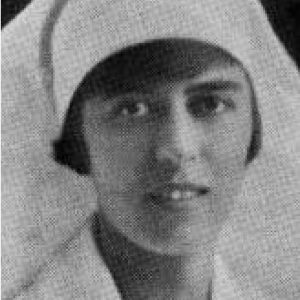
Marjorie Brenchley (1896-1942)
Nurse and martyr.
Click for More
One of the New Guinea Martyrs, Margery Brenchley was a nurse who went to New Guinea in 1927. She was captured by the advancing Japanese army and killed in 1942.
Margery was born in England but migrated to Australia with her brother when she was a teenager. Recognising that nursing was her vocation, she entered Brisbane Hospital for training. While in training she attended the parish of Holy Trinity, Fortitude Valley. They supported her as their missionary from the time she went to New Guinea in 1927 until her death.
Those who knew her as a mission nurse described her as slightly built, usually dressed in brown, with dark hair and eyes, totally devoted to the care of the native people. When Henry Holland moved to the new station of Isivita, she shared the responsibility of running the Sangara station with Lilla Lashmar. From this lonely spot she sometimes travelled to Gona alone with a sick patient.
The mission house and all its furniture was made mostly from local bush materials but they also used the packing boxes in which equipment was carried up from the coast. Their isolation was slightly mitigated by the presence, at a short distance, of the manager of the rubber plantation Louis Austen and his wife.
In July 1942 Margery Brenchley and Lilla Lashmar declined an offer from Australian servicemen to travel to Port Moresby with them, but as their post lay in the direct line of the advancing Japanese, they moved to Isivita, accompanied by Lucian Tapiedi. Early on 22nd July the mission staff began to build a secret camp in the bush for the Europeans.
After a week Henry Holland consulted Andrew Aware and it was agreed that they were not safe in their hide-out, with patrols passing so close all the time and Lucian and Andrew making daily visits. It was then that the decision to travel to the coast was made. A decision which led to their capture and death on Buna beach.
Read further on the journey of Women’s History in the Church
You are on Page 1: Women in Brisbane Diocese
2 Women’s Organisations 3 Early Women’s Missionaries 4 Emerging Leaders 5 MOW 6 Ordination Achieved